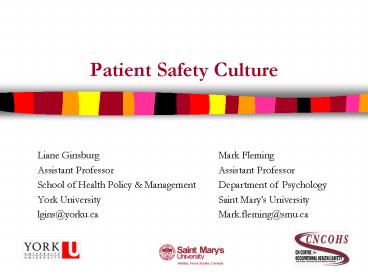Patient Safety Culture - PowerPoint PPT Presentation
1 / 16
Title:
Patient Safety Culture
Description:
Patient Safety Culture. Liane Ginsburg. Assistant Professor. School of ... for a change in culture are little more than feel good messages' p153 (Vincent, 2006) ... – PowerPoint PPT presentation
Number of Views:397
Avg rating:3.0/5.0
Title: Patient Safety Culture
1
Patient Safety Culture
- Liane Ginsburg
- Assistant Professor
- School of Health Policy Management
- York University
- lgins_at_yorku.ca
Mark Fleming Assistant Professor Department of
Psychology Saint Mary's University Mark.fleming_at_sm
u.ca
2
Patient Safety Culture - Outline
- Why is it important?
- What is it?
- How is it measured?
- How might the data be used?
- Do we need different tools for different sectors
/ staff groups?
3
Importance of culture
- There is a need for a cultural change, the status
quo is no longer acceptable (IOM, 1999) - The Change foundation recommends Creating a
culture of safety to improve patient safety
(February 2004) - The Canadian Patient Safety Institute will
- influence change in culture to improve patient
safety
4
Everything and nothing
- Sometimes culture is just a lazy catch all term
for a mishmash of practices that are somehow
meant to combine to produce a coherent approach
to safety calls for a change in culture are
little more than feel good messages p153
(Vincent, 2006)
5
Organisational Culture
- Culture has been defined as
- A pattern of basic assumptions
- Invented, discovered or developed by a given
group - Learnt from coping with problems of external
adaptation and internal integration - That has worked well enough to be considered
valid - Is taught to new members (as the)
- Correct way to perceive, think and feel in
relation to problems - Schein 1990 p110
6
Culture model
Culture
Basic Assumptions(Taken for granted/ unconscious)
Artefacts(Indicators)
Espoused values(Attitudes about Systems
PeopleBehaviour)
7
Why the interest in Safety Culture?
- It is thought to be related to actual levels of
patient safety it is used as a proxy for safety
as it is more easily quantifiable - Coercive and normative mechanisms
8
How do we Measure Safety Culture?
- Quantitative approaches
- Just learning about their sensitivity to
differences between units / organizations and to
change over time - Is it a org or unit-level phenomenon? This has
really practical implications for who and how
many to survey and how to report the data for an
organization - Qualitative approaches
- Provide a kind of depth and richness that is
quite different
9
Areas Measured
- AHRQ Dimensions
- Overall perceptions of safety
- Frequency of events reported
- Supervisory Leadership
- Organizational learningcontinuous improvement
- Teamwork within units
- Communication openness
- Feedback communication about error
- Nonpunitive response to error
- Staffing
- Hospital management support for patient safety
- Teamwork across hospital units
- Hospital handoffs transitions
- PLUS
- Patient safety grade
- of events individuals reported in last 12
months - MSI Dimensions
- Valuing Safety in the Organization
- Supervisory Leadership
- Fear of Repercussions
- State of Safety
10
How its done Quantitatively
- Tools available that organizations can implement
on their own - Freedom to do as needed can be used for internal
diagnosis and monitoring - This capacity is important once we have the right
tool (eg that will be sensitive to diffs /
change) - AHRQ promotes this, we are working on it with the
MSI through use of survey implementation
resources / handbook - External comparison becomes more problematic due
to inconsistent methods and samples
11
How its done Qualitatively
- Interviews and focus groups can be used to
- Help assess how well surveys are detecting real
differences in safety culture (done more in a
research) - As a proactive or reactive mechanism to promote
learning and improvement and move safety forward - unit specific dialogue to diagnose problems,
bring discussion of the culture of safety to the
surface, monitor progress in improving culture - may be a valuable, yet underutilized tool for
enhancing safety - requires a certain level of immediate supervisory
commitment - would also fit with more senior level commitment
and leadership walkarounds
12
How to Use the Data
- Identification of learning opportunities
- Areas with low scores relative to other areas
- Units or organizations with low scores relative
to other units / orgs - Learning from best practice places seems to be
terribly under-utilized as a strategy for
implementing change - Some areas easier to address than others valuing
safety, reporting practices, state of safety,
supervisory leadership
13
Performance / Improvement Learning Tool
14
What we are Doing in CPSI study
- Testing instruments value with different staff
groups and sectors with 2 large samples - Testing instruments sensitivity to change and
differences using qualitative approaches - Looking at links between safety culture data and
safety improvement activity - Fall 2006 data to build pan-Canadian Database
- Trying to create org capacity to measure their
own culture while continuing to build national
capacity to learn from one another using the
pan-Canadian database
15
Staff / Sector Specific Measurement
- Preliminary analysis suggests the MSI works
reasonably well across settings / sectors, but
has some applicability issues wrt staff groups - the MSI works equally well across different
in-patient settings (general acute, LTC, acute
MH) - MSI has a set of 5 or so items that apply only to
those staff members involved in direct care
16
Using the MSI in Pediatric Settings
- MSI has been used in one large childrens
hospital - Prelim analysis suggest it works well
- Instrument works well in LTC and acute MH
settings - Consideration needs to be given to whether
pediatric sites would benefit from questions in
additional domains






























![[PDF] Patient Safety and Hospital Accreditation: A Model for Ensuring Success Free PowerPoint PPT Presentation](https://s3.amazonaws.com/images.powershow.com/10084340.th0.jpg?_=20240724015)
